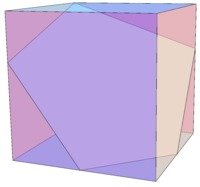Since the edge of a regular pentagon inscribed in a unit cube is approximately 0.77437 76951 36495 67221 40842 57670 14333 23639, your answer is just twice this number.
The question concerning regular polygons inscribed in a cube is quite challenging. It's obvious how to place the largest equilateral triangle inside a cube and the larger possible hexagon is also well known. The placement for the largest square is not so obvious but the length of the edge of the largest square in a unit cube is 1.060660172=(sqrt(2*0.75^2)). The largest pentagon lies as shown in the diagram. Three of the edges lie in three of the cube faces; the other two edges are inside the cube and their intersect is on the top face of the cube. The center of this pentagon does not coincide with the center of the cube. As far as I know, the size of regular polygons with more than 6 edges that can be inscribed in a cube have not been calculated.

